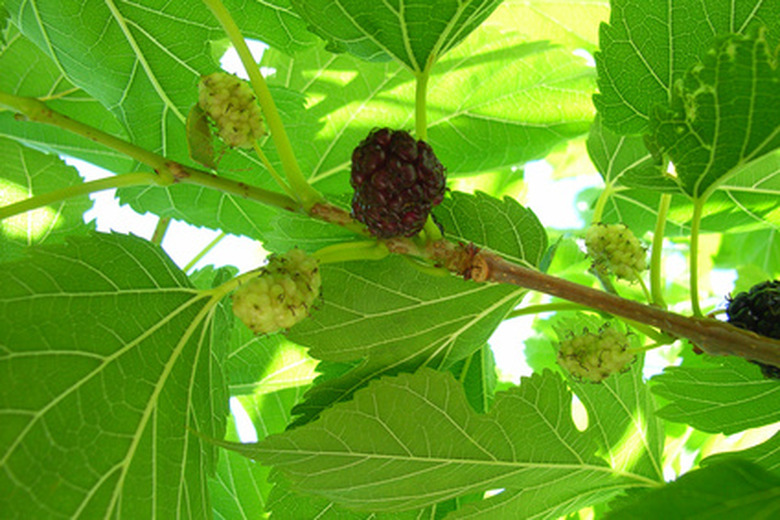Mulberry Tree Fungus
There are two common species of mulberry trees: native red and Asia white. It produces edible fruit, but it can be mildly toxic if it hasn't ripened yet, according to the Nursery at TyTy. Mulberry trees can be susceptible to fungus infection, which could in turn wreak havoc on your entire landscape. Though most trees are susceptible to fungi, you can maintain proper care as a preventative method. Know what to look for and how to control it should a problem arise.
Care
Mulberry trees have smooth, delicate bark that is easily injured. Fungal pathogens are much more likely to invade through wounds or any other cracks on injured, weakened trees than on unmarred, vigorous trees, according to the University of Arizona Extension Plant Pathology. Grow mulberry trees in locations that offer full sun to partial shade. Mulberries prefer moist, well-draining soil and are tolerant to dry conditions, according to the University of Illinois Extension HortAnswers. Avoid waterlogged soils that invite fungal germination.
- There are two common species of mulberry trees: native red and Asia white.
- Fungal pathogens are much more likely to invade through wounds or any other cracks on injured, weakened trees than on unmarred, vigorous trees, according to the University of Arizona Extension Plant Pathology.
Infection
Sooty canker is a wilt disease that primarily affects mulberry trees, among other plants, throughout the southwestern United States due to an ideal dry, warm climate that follows a mild winter within which fungi thrive, according to the University of Nevada Cooperative Extension. This infection spreads sporadically on wind and rain as well as through carrier animals.
Effects
Besides leaf wilt, Mulberry sooty canker fungus causes cankers or lesions of dead tissue on limbs that first appear watery and change to a brown color. As symptoms progress, branches experience dieback, leaves become brown and die but do not fall from the tree, new growth is stunted and cankers break open, revealing spores that resemble black dust or soot, as the name suggests. If infection spreads to the trunk, tree death occurs, according to the University of Nevada Cooperative Extension.
Hosts
Since spores spread from one tree to the next, the more hosts you grow in your home garden, the greater your chance for the spread of fungus. Keep these host plants in mind as you make your selection to avoid creating a prime target for mulberry tree fungus. Susceptible host trees include, but are not limited to, almond, apple, citrus, fig, plum, sycamore and wisteria, according to the University of Nevada Cooperative Extension.
- Sooty canker is a wilt disease that primarily affects mulberry trees, among other plants, throughout the southwestern United States due to an ideal dry, warm climate that follows a mild winter within which fungi thrive, according to the University of Nevada Cooperative Extension.
Control
To control fungus on your mulberry tree, paint the main branch tips and the trunk with reflective white latex paint that prevents sunburn, which increases the chance for fungal infection. Remove and destroy affected plant parts. For exposed branch tips after pruning, apply a copper fungicide like Bordeaux to the area to keep fungi from re-invading. Additionally, even if your tree shows no signs of a fungal infection, apply copper fungicides to any wounds to prevent invasion. The best control is keeping your tree vigorous and wound-free, according to the University of Nevada Cooperative Extension.
